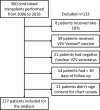High Incidence of Herpes Zoster After Cord Blood Hematopoietic Cell Transplant Despite Longer Duration of Antiviral Prophylaxis
- PMID: 32150265
- PMCID: PMC8075034
- DOI: 10.1093/cid/ciaa222
High Incidence of Herpes Zoster After Cord Blood Hematopoietic Cell Transplant Despite Longer Duration of Antiviral Prophylaxis
Abstract
Background: Cord blood transplant (CBT) recipients have a high incidence of herpes zoster (HZ) in the context of short-term peritransplant antiviral prophylaxis. In 2009, international guidelines recommended HZ prophylaxis for at least 1 year after hematopoietic cell transplant. The impact of longer-term antiviral prophylaxis on HZ incidence after CBT is unknown.
Methods: We retrospectively analyzed varicella zoster virus (VZV)-seropositive CBT recipients who were transplanted between 2006 and 2016. We abstracted HZ events and other variables for up to 5 years post-CBT. We calculated the cumulative incidence of HZ and used Cox proportional hazards regression to identify variables associated with HZ.
Results: The study cohort consisted of 227 patients. Among 1-year survivors, 91% were still receiving prophylaxis, for a median duration of 20.6 months. HZ occurred in 44 patients (19%) at a median of 23.6 months. The cumulative incidence of HZ by 1 year after CBT was 1.8% (95% confidence interval [CI], .1%-4%), but increased to 26% (95% CI, 19%-33%) by 5 years. In a multivariable analysis, acute graft-vs-host disease was associated with increased risk, whereas antiviral prophylaxis was associated with reduced risk for HZ (adjusted hazard ratio, 0.19 [95% CI, .09-.4]). There was no association between CD4+ T-cell counts at 1 year post-CBT and subsequent risk for HZ.
Conclusions: We found a high incidence of HZ after CBT despite antiviral prophylaxis for > 1 year. Based on these findings, we suggest longer duration of prophylaxis for HZ after CBT. Compliance with antiviral prophylaxis, VZV-specific immune monitoring, and vaccination to mitigate HZ after CBT also require further study.
Keywords: antiviral; cord blood; hematopoietic cell transplant; prophylaxis; varicella zoster virus.
© The Author(s) 2020. Published by Oxford University Press for the Infectious Diseases Society of America. All rights reserved. For permissions, e-mail: journals.permissions@oup.com.
Figures


Similar articles
-
Long-Term Incidence of Varicella Zoster Virus Disease in Adults Receiving Single-Unit Cord Blood Transplantation.Transplant Cell Ther. 2022 Jun;28(6):339.e1-339.e7. doi: 10.1016/j.jtct.2022.03.022. Epub 2022 Mar 29. Transplant Cell Ther. 2022. PMID: 35364334
-
Herpes Zoster in Autologous Hematopoietic Cell Transplant Recipients in the Era of Acyclovir or Valacyclovir Prophylaxis and Novel Treatment and Maintenance Therapies.Biol Blood Marrow Transplant. 2017 Mar;23(3):505-511. doi: 10.1016/j.bbmt.2016.12.620. Epub 2016 Dec 28. Biol Blood Marrow Transplant. 2017. PMID: 28039754 Free PMC article.
-
High incidence of herpes zoster in nonmyeloablative hematopoietic stem cell transplantation.Biol Blood Marrow Transplant. 2011 Jul;17(7):1012-7. doi: 10.1016/j.bbmt.2010.10.025. Epub 2010 Oct 25. Biol Blood Marrow Transplant. 2011. PMID: 20977944 Free PMC article.
-
Effectiveness of acyclovir prophylaxis against varicella zoster virus disease after allogeneic hematopoietic cell transplantation: A systematic review and meta-analysis.Transpl Infect Dis. 2019 Jun;21(3):e13061. doi: 10.1111/tid.13061. Epub 2019 Mar 1. Transpl Infect Dis. 2019. PMID: 30756465
-
Varicella Zoster Virus Reactivation in Adult Survivors of Hematopoietic Cell Transplantation: How Do We Best Protect Our Patients?Biol Blood Marrow Transplant. 2018 Sep;24(9):1783-1787. doi: 10.1016/j.bbmt.2018.04.003. Epub 2018 Apr 10. Biol Blood Marrow Transplant. 2018. PMID: 29653205 Review.
Cited by
-
Reduced immunogenicity of the adjuvanted recombinant zoster vaccine after hematopoietic cell transplant: a pilot study.Blood Adv. 2020 Oct 13;4(19):4618-4622. doi: 10.1182/bloodadvances.2020002269. Blood Adv. 2020. PMID: 32991718 Free PMC article.
-
Enhancing Efficacy and Quality of Life in Patients with Herpes Zoster Infection in Hairy Cell Leukemia.Case Rep Hematol. 2024 Feb 26;2024:1575161. doi: 10.1155/2024/1575161. eCollection 2024. Case Rep Hematol. 2024. PMID: 38440158 Free PMC article.
-
Towards personalized prevention of Herpes zoster infection in patients with hematologic diseases or hematopoietic stem cell transplant recipients: a position paper from an <I>ad hoc</I> Italian expert panel.Haematologica. 2024 Nov 1;109(11):3496-3504. doi: 10.3324/haematol.2023.284417. Haematologica. 2024. PMID: 38105723 Free PMC article. Review.
-
How I prevent viral reactivation in high-risk patients.Blood. 2023 Apr 27;141(17):2062-2074. doi: 10.1182/blood.2021014676. Blood. 2023. PMID: 36493341 Free PMC article. Review.
-
Assessing and restoring adaptive immunity to HSV, VZV, and HHV-6 in solid organ and hematopoietic cell transplant recipients.Clin Microbiol Infect. 2022 Oct;28(10):1345-1350. doi: 10.1016/j.cmi.2022.02.001. Epub 2022 Feb 10. Clin Microbiol Infect. 2022. PMID: 35150885 Free PMC article. Review.
References
-
- Koc Y, Miller KB, Schenkein DP, et al. . Varicella zoster virus infections following allogeneic bone marrow transplantation: frequency, risk factors, and clinical outcome. Biol Blood Marrow Transplant 2000; 6:44–9. - PubMed
-
- Yagi T, Karasuno T, Hasegawa T, et al. . Acute abdomen without cutaneous signs of varicella zoster virus infection as a late complication of allogeneic bone marrow transplantation: importance of empiric therapy with acyclovir. Bone Marrow Transplant 2000; 25:1003–5. - PubMed
-
- Grant RM, Weitzman SS, Sherman CG, Sirkin WL, Petric M, Tellier R. Fulminant disseminated varicella zoster virus infection without skin involvement. J Clin Virol 2002; 24:7–12. - PubMed
-
- Onozawa M, Hashino S, Haseyama Y, et al. . Incidence and risk of postherpetic neuralgia after varicella zoster virus infection in hematopoietic cell transplantation recipients: Hokkaido Hematology Study Group. Biol Blood Marrow Transplant 2009; 15:724–9. - PubMed
-
- Kanbayashi Y, Matsumoto Y, Kuroda J, et al. . Predicting risk factors for varicella zoster virus infection and postherpetic neuralgia after hematopoietic cell transplantation using ordered logistic regression analysis. Ann Hematol 2017; 96:311–5. - PubMed
Publication types
MeSH terms
Substances
Grants and funding
LinkOut - more resources
Full Text Sources
Medical
Research Materials

